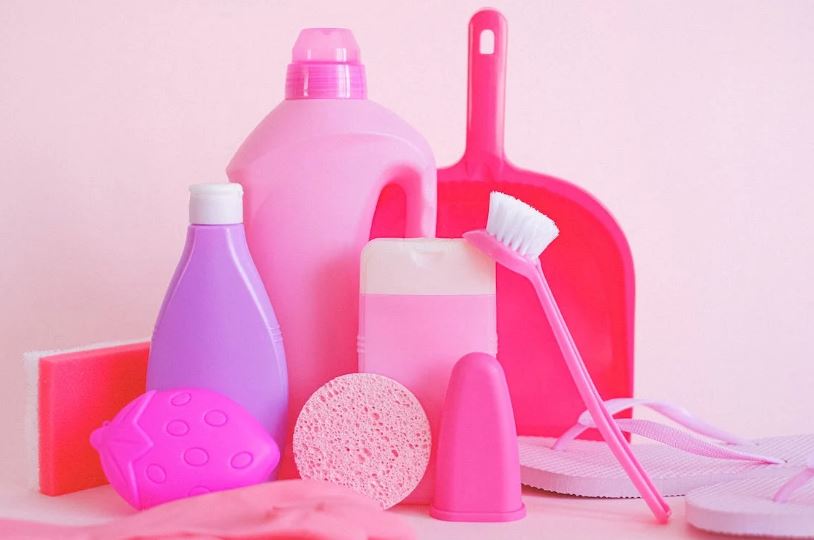Bathtubs are a simple method to relieve tension, but grime buildup and stains can make an evening dip less soothing. In the absence of regular cleaning, germs, grime, hard-water deposits, soap scum, and even mold or mildew can accumulate in and around your tub. Follow this simple advice on how to clean a bathtub, including the drain, grout lines, and caulking, to maintain the luster of your bathtub and guarantee that it is ready for use.
Incorporate the following steps into your cleaning regimen for a bathtub that sparkles in no time.
1. Bathtub Cleaning
Consider the bathtub’s structure when determining the optimal cleaning method. All of the most prevalent materials, including fiberglass, acrylic, porcelain-enameled steel, and stone resin, require distinct cleaning considerations. Acrylic and fiberglass bathtubs, for instance, can be easily scratched by abrasive equipment or cleaners, whilst porcelain enamel surfaces are susceptible to flaking and rust.
Tub cleaning is a tedious task that everyone wishes to avoid. While you can’t avoid scrubbing the bathtub forever, regular upkeep can keep rigorous cleaning to a minimum (we hesitate to even call these moves cleaning). Therefore, if you follow these simple instructions, you’ll have a gleaming bathtub with less effort.
How to Clean a Bathtub
- Fill a pail with hot water and pour it all over the bathtub.
- Pour a half gallon of hot water and two tablespoons of dish soap into your bucket.
- Soak a cleaning sponge or stiff nylon brush in the bucket and scrub all surfaces of the bathtub.
- Use the bucket to rinse the sponge or brush frequently and to transfer soapy water to the tub.
- Using a clean, dry cloth, polish the tub’s faucet, drain, and handles.
Cleaning a Bathtub Drain
If your drain is clogged or hasn’t been cleaned in a while, take a few minutes to clean this region as you clean the bathtub if it is running slowly or hasn’t been cleaned in a while. Put on gloves and use a straightened wire hanger (with one end bent into a hook) to remove hair and other obstructions from a drain. Pour hot water down the drain afterward. Pour 1 cup of baking soda and 1 cup of vinegar down the drain to eliminate any leftover buildup. Wait 15 minutes before using hot water to flush.
2. Bathroom Tub Waxing
Regularly applying a wax polish will prevent damage to the bathtub. This ensures that water and residue do not remain in areas where they should not. Using a wax polish helps to temporarily seal minor cracks until they can be repaired.
You can use regular automobile wax to clean your bathtub, but if you’re uncomfortable with the concept, you can alternatively purchase wax designed for bathroom fixtures.
3. Mend Cracks
Damaged tiles or grout should be reported to a plumber so that an expert may analyze the situation. Cracks in tiles can lead to the formation of mold, which, if left unchecked, can cause significant sickness. Once a year, seal any tiles that are loose or damaged. This will prevent water from entering the wall cavities, hence preventing any potential harm from water infiltration.
4. Caulk is Your Friend
Silicone caulk can seal any potential issues to guarantee that nothing is destroyed. Regularly inspect the caulk at changeover points (about once a year). The lifespan of caulk is around five years.
How to Clean Caulk or Grout Around the Bathtub
If your tub is constructed into an alcove or is part of a tub-and-shower combination, you must also regularly clean the surrounding regions. To remove stains and hard water deposits from a tiled tub surround, spritz the area with a tile cleaner and scrub the surface gently. Utilize a grout brush and a solution of baking soda and water to eliminate dirt between tiles. To clean the caulk or sealant around the bathtub, create a thick paste by combining a tiny amount of chlorine bleach with baking soda. Apply the paste to the caulk and let it remain for approximately ten minutes before rinsing thoroughly. If the region is especially moldy or damaged, it may be necessary to remove and replace the caulk.
5. Bathtub Doors
Bathtubs with sliding doors should be inspected frequently to ensure that water is not accumulating in the mechanism and breeding bacteria and residue. If water is accumulating, the drainage system may not be functioning properly and must be inspected.
Regularly inspecting the door will ensure that everything is clean and functioning properly. If you have an issue with water leaking everywhere, it will be more expensive to fix, therefore if the problem is severe, you should contact a plumber for assistance.
6. Regular Use
There are things you can do between routine bathtub maintenance to help avoid mold and difficult-to-remove soap scum and stains. After a bath or shower, ensure that no shampoo or soap remains on the tub’s surface by rinsing everything down the drain. Additionally, you should wipe down your shower curtain or door with a dry towel to prevent mildew growth caused by excessive moisture. These easy actions will make the weekly cleaning less laborious.
To sum up
To prevent the accumulation of bacteria in your bathroom, you must maintain a clean bathtub. In addition to cleaning, frequent bathtub maintenance will prevent greater, more expensive problems. You will not have to cope with weeks or months’ worth of filth buildup if you clean regularly and thoroughly. If you discover a fracture in your bathtub, it is crucial to repair it immediately so that it does not lead to more expensive problems.
Ultimately, maintaining a consistently clean bathtub needs diligence and discipline. Attempt to rinse the tub surface with clean, warm water after each use, or as frequently as possible, and then remove excess moisture using a wiper, microfiber cloth, or sponge. This goes a long way toward preventing soap scum, mildew, and dirt, which eliminates the need for more extensive and laborious cleaning.




